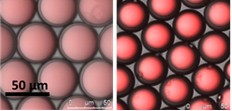Droplet based microfluidics
(Esther Amstad, November 14, 2013)
 Everybody knows a faucet that drips because it is leaking; this can be extremely annoying. However, have you ever thought what determines the size of these drops and how they can be used to produce new materials? Esther Amstad, a Postdoc at Harvard University in the group of David A. Weitz, does exactly that. She uses drops as templates to build new materials such as stimuli-responsive capsules that can efficiently be loaded with cargo and enable good control over its release kinetics. To enable the assembly of these materials, she designs new microfluidic devices to push the limits of this technique towards smaller drop sizes and higher throughputs. The new materials are not only of scientific interest but also make it possible to industrialize some of these products; therefore, she closely collaborates with different industrial partners. In June 2014, Esther Amstad will move to Lausanne as an assistant professor in the Material Science department at EPFL. She and her group will further exploit the exquisite flow control afforded by microfluidic techniques to design new types of soft materials.
Everybody knows a faucet that drips because it is leaking; this can be extremely annoying. However, have you ever thought what determines the size of these drops and how they can be used to produce new materials? Esther Amstad, a Postdoc at Harvard University in the group of David A. Weitz, does exactly that. She uses drops as templates to build new materials such as stimuli-responsive capsules that can efficiently be loaded with cargo and enable good control over its release kinetics. To enable the assembly of these materials, she designs new microfluidic devices to push the limits of this technique towards smaller drop sizes and higher throughputs. The new materials are not only of scientific interest but also make it possible to industrialize some of these products; therefore, she closely collaborates with different industrial partners. In June 2014, Esther Amstad will move to Lausanne as an assistant professor in the Material Science department at EPFL. She and her group will further exploit the exquisite flow control afforded by microfluidic techniques to design new types of soft materials.